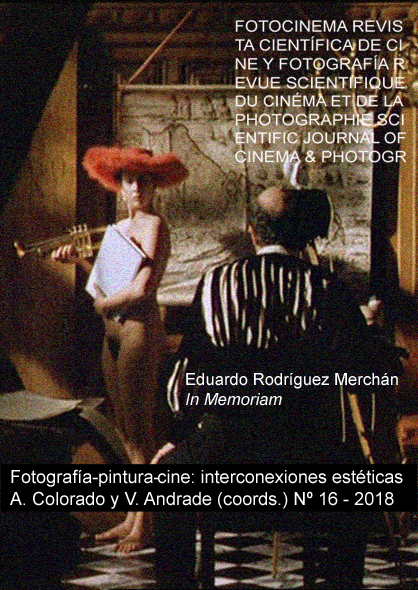VFX y CGI: la imagen digital y los procesos tradicionales en el cine. Entrevista a Elio Quiroga
DOI:
https://doi.org/10.24310/Fotocinema.2018.v0i16.4101Keywords:
Cine, Elio Quiroga, VFX, CGIAbstract
El cine, como industria cultural, comienza a desbordar gran parte de su desarrollo en vertientes cada vez más orientadas hacia las ya casi innumerables herramientas tecnológicas y digitales. Términos como VFX o CGI no son si no una generalidad prácticamente utópica desde la que comenzar a estudiar una situación ampliamente heterogénea, así como en amplios momentos exclusiva del cine americano. Elio Quiroga, escritor y director de cine carente de miedo ante la distopía, el avance tecnológico y la imaginación en sus entregas e investigaciones, trata de arrojar un poco de luz sobre los factores y relaciones que acontecen entre la herencia y el hacer del cine más tradicional y las innovaciones más recientes de la industria.Downloads
Metrics
References
Cuestión de Tiempo (Elio Quiroga, 1987) - Director y guionista
Compramos Gente (Elio Quiroga, 1988) - Director y guionista
Fotos (Elio Quiroga, 1996) - Director y guionista
El Último Minutero (Elio Quiroga, 2004) - Director y guionista
Home Delivery (Elio Quiroga, 2005) - Director y guionista
Ausentes (Daniel Calparsoro, 2005) - Co-guionista
Uwe (Elio Quiroga, 2006) - Director y guionista.
La hora fría (Elio Quiroga, 2007) - Director y guionista.
No-Do (Elio Quiroga, 2009) - Director y guionista.
My name is Maria (Mi nombre es María, Elio Quiroga, 2010) - Director y guionista.
Paris 1944 - 2012, Color of Time (Elio Quiroga, 2012) - Director y guionista.
Science Gossip (Elio Quiroga y Luis Sánchez-Gijón, 2014) Co-productor y guionista
The Mystery of the King of Kinema (Elio Quiroga, 2014) - Director y guionista.
Sirena Negra (Elio Quiroga, 2015) - Director
Downloads
Published
How to Cite
Issue
Section
License
All contents published in Fotocinema Revista científica de cine y fotografía are protected under the Creative Commons Attribution-NonCommercial-ShareAlike 4.0 International (CC BY-NC-SA 4.0) license. All about this license is available in the following link: <http://creativecommons.org/licenses/by-nc-sa/4.0>
Users can copy, use, redistribute, share and exhibit publicly as long as:
- The original source and authorship of the material are cited (Journal, Publisher and URL of the work).
- It is not used for comercial purposes.
- The existence of the license and its especifications are mentioned.
There are two sets of authors’ rights: moral and property rights. Moral rights are perpetual prerogatives, unrenounceable, not-transferable, unalienable, imprescriptible and inembargable. According to authors’ rights legislation, Fotocinema. Revista científica de cine y fotografía recognizes and respects authors moral rights, as well as the ownership of property rights, which will be transferred to University of Malaga in open access. The property rights are referred to the benefits that are gained by the use or the dissemination of works. Fotocinema. Revista científica de cine y fotografía is published in an open access form and it is exclusively licenced by any means for doing or authorising distribution, dissemination, reproduction, , adaptation, translation or arrangement of works.
Authors are responsable for obtaining the necessary permission to use copyrighted images.













13.png)



